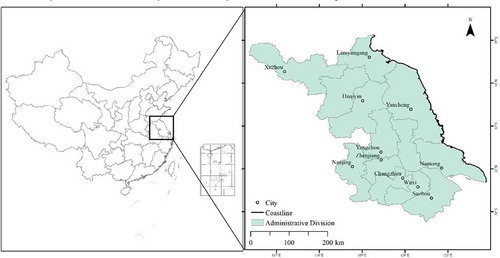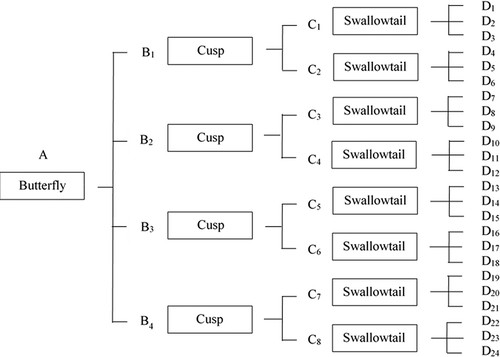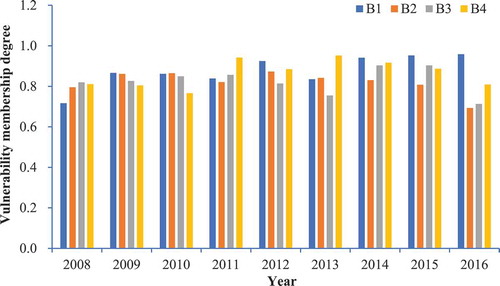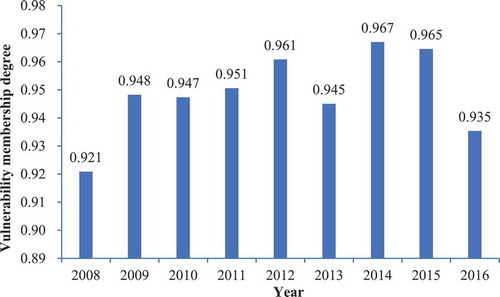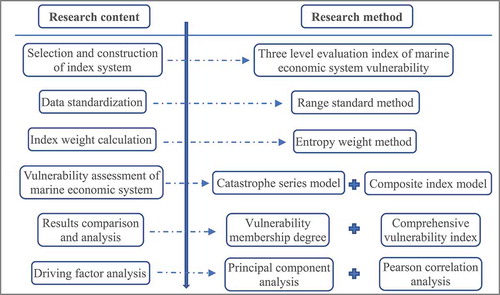 ?Mathematical formulae have been encoded as MathML and are displayed in this HTML version using MathJax in order to improve their display. Uncheck the box to turn MathJax off. This feature requires Javascript. Click on a formula to zoom.
?Mathematical formulae have been encoded as MathML and are displayed in this HTML version using MathJax in order to improve their display. Uncheck the box to turn MathJax off. This feature requires Javascript. Click on a formula to zoom.ABSTRACT
The sustainable development of the marine economic system to accurately grasp the dynamic evolution characteristics and main driving factors of the vulnerability of the marine economic system so as to effectively identify the problems in the operation of the marine economy is extremely important. Based on the establishment of a three-level assessment index system for the vulnerability of the marine economic system, the vulnerability of the marine economic system of Jiangsu Province in 2008–2016 was evaluated by using the comprehensive index model and the catastrophe progression model, and the results were compared based on the unified evaluation criteria. The main influencing factors were analyzed by principal component analysis and Pearson correlation analysis. It’s found that 2014, 2015, and 2012 are in a general state, 2009 and 2010 are in a poor state, and the vulnerability state from 2008 to 2011 is lower than that in 2012. The overall volatility is small indicating a stable system. Among them, the scale of marine industry and profit and loss of marine resources are the main components of marine economic system vulnerability having the highest correlation with the vulnerability of marine economic system. This study enriches the theoretical method and empirical research on the vulnerability of the marine economic system and has practical significance in allowing for timely targeted control measures to affect the vulnerability of the marine economic system.
Introduction
Coastal areas are the regions with the most concentrated population, the fastest economic development, the largest economic aggregate scale, the most economic vitality, and development potential in the world. At the same time, it’s also an area with high demand for marine resources with high intensity of development and utilization, and concentrated pollutant discharge. With further development of coastal areas, while simultaneously realizing the rapid growth of marine economy, the demand for the development and utilization of marine resources is increasing. The resulting pressure on the marine environment is increasing (Berrouet, Machado, and Villegas-Palacio Citation2018). A series of problems and risks have gradually emerged, such as: the low efficiency of marine resources utilization, the decline of biodiversity, the aggravation of environmental pollution, the low quality of economic development, the extensive mode of economic growth, and the increasing pressure of economic transformation (Fernández-Macho, González, and Virto Citation2020). Therefore, the study of the dynamic evolution of vulnerability of marine economic system and its main influencing factors is urgently needed. How to reduce the vulnerability of marine economic system has become an intense topic in the field of marine sustainable development.
The marine economic system is a comprehensive system formed by interweaving the natural marine ecosystem characteristics with the socio-economic system located in the coastal zone. Specifically, each marine industry with natural, social, scientific, and technological factors as production factors is located in a geographical space. Each geographical space with its own social environment, economic environment, resource environment, and ecological environment with certain marine characteristics as comprehensive environment forming a complex system of interrelation, interaction, and mutual restriction (Kantamaneni et al. Citation2018). The marine economic system is usually affected by multiple internal and external interference factors, with the internal factors mainly composed of the marine industrial structure (structure), immunity to withstand external shocks (bearing capacity), the ability to transform scientific and technological achievements (development capacity), and the level of industrialization (control capacity) (Li et al. Citation2018). The external influencing factors mainly include natural disasters, ecological environment, location environment, supply capacity of marine resources, stability of global economy, integrated marine management, and political and economic system factors (Sun, Cao, and Wang Citation2019). The vulnerability of marine economic system is the result of the interaction of internal and external factors mainly due to internal structure constraints, external stress, and disturbance impact, as well as the lack of resilience. When the internal and external impact is large and the response is weak, the vulnerability is more obvious. When the internal and external interference is small, and, the coping ability is strong, the vulnerability is not obvious. Vulnerability is an essential attribute and will always exist in marine economic development. Its connotation mainly includes the instability of the marine economic system itself, sensitivity to the changes of various factors, and the ability to withstand external influences. The stable development of marine economic system has become an important part of comprehensive national strategies of developed countries including the United States, Britain, Russia, France, Japan, and others (Hu et al. Citation2019). These countries used vulnerability assessment as a tool for coastal and marine disaster management (Nelson et al. Citation2020). With the transformation of marine economy from the stage of high-speed growth to the stage of high-quality development, the key issues have evolved to include reducing the vulnerability of the marine economic system, improving the response capacity of the marine economy, and realizing the high-quality development of the marine economy (Lauerburg et al. Citation2020).
Catastrophe theory is a mathematical framework that deals with discontinuous transitions between the states of a system, given smooth variation of the underlying parameters (Roopnarine Citation2008). Catastrophe progression model is a type of multi-level contradiction decomposition of evaluation target, which combines catastrophe theory with fuzzy mathematics to produce catastrophe fuzzy membership function. It’s a comprehensive evaluation method for ranking and analyzing the evaluation objectives by calculating the total membership function (Nadiri et al. Citation2018). The feature of this model is that it does not use weights for indicators, but it takes into account the relative importance of each evaluation indicator to reduce subjectivity without losing rationality while keeping calculations simple and accurate (Lakhvinder et al. Citation2020). It has a wide range of applications, such as groundwater vulnerability assessment (Sadeghfam et al. Citation2016), coastal water pollution disaster assessment, vulnerability to saltwater intrusion (Sadeghfam et al. Citation2020b), evaluation and management of sustainable utilization of water resources (Chen et al. Citation2016), pollution disaster in near-shore coastal waters (Wang et al. Citation2011), and island ecological environment assessment (Gao et al. Citation2019). Based on the relevant research results, this paper selects and constructs a three-level evaluation index system of vulnerability of marine economic system using the catastrophe progression model to evaluate the vulnerability of marine economic system verified with a comprehensive index model. Combined with the analysis of the main influencing factors, the paper puts forward reasonable policy suggestions, enriching the relevant empirical cases. Through vulnerability research, it’s helpful to identify the problems in the operation of marine economic system, take timely regulatory measures, and enhance the ability of marine economic system to cope with fluctuations. It’s helpful to reveal the regional differences of vulnerability, reduce the differences of regional marine economic development, and promote the coordinated development of land and sea. It’s helpful to promote the adjustment of marine industrial structure and has important theoretical and practical significance to promote the coordinated development of marine economy and resources and environment.
Materials and methods
Research area status and data sources
Jiangsu Province of China is located in 116°18ʹE~121°57ʹE, 30°45ʹN~35°20ʹN. The total land area of the region is 10.26 × 104km2, accounting for 1.06% of the total land area of China, and the coastal area is about 3.5 × 104km2. The sea area is 3.75 × 104km2, and the total length of coastline is 888.9 km (). Jiangsu Province is located in the Yangtze River economic belt. Its per capita GDP, comprehensive competitiveness, regional development, and people’s livelihood index (DLI) are all at the forefront of China’s provinces, becoming one of the provinces with the highest comprehensive development level and the most active economy. By the end of 2019, the urbanization rate has reached 70.61%, and the contribution rate of Yangtze River city group to the economic growth of the whole province has reached 78.4%. The contribution rate of coastal economic belt to the economic growth of the whole province is 16.5%. With the rapid development of marine economy, the demand of marine resources development and the pressure of marine environmental protection gradually increase. It faces a series of problems and risks, such as extensive economic growth mode, increasing transformation pressure, low utilization efficiency of marine resources, and aggravation of environmental pollution. Therefore, it’s of great significance to select Jiangsu Province as the research object to evaluate the vulnerability of marine economic system and analyze the main influencing factors.
The relevant data of this work mainly come from China’s Marine Statistical Yearbook, China’s fishery statistical yearbook, China’s port Yearbook, Jiangsu Province Statistical Yearbook, Jiangsu Province marine economic development report, and other socio-economic statistical data from 2008 to 2016. Among them, the relevant data of marine resources and marine ecological environment mainly come from the sea use planning report of the research area, marine environmental impact assessment report, sea area use demonstration report, monitoring data and emission declaration data of environmental protection department, field survey data, and model calculation data.
Assessment model
Entropy weight
Entropy weight method determines the objective weight according to the variation of index. The smaller the information entropy of an index, the greater the variation degree of the index value; the more information it provides, the greater the role it can play in the comprehensive evaluation and the greater the weight. On the contrary, the larger the information entropy of an index, the smaller the variation degree of the index value, the less the information provided, the smaller the role played in the comprehensive evaluation, and the smaller the weight. The evaluation indexes of different unit values are standardized, and the formula is as follows:
For benefit type indicators: ; For cost indicators:
In the formula, yij is the evaluation value of the i-th index, xij is the standardization coefficient, maxxij is the maximum value, minxij is the minimum value.
The importance of each index in the index system is reflected by entropy weight, and the calculation formula is as follows:
In the formula, eij is the standard value of index J. yij is the proportion of the total standard value in the i-th sample year. hij is the information entropy of index J. wij is the index entropy weight and 0≤ wij≤1, ∑wij = 1. n is the number of samples, m is the number of evaluation indicators, i = 1, 2, … n, j = 1, 2, … m.
Comprehensive index model
The comprehensive index is the sum of multiplying the standardized value of each index by its weight. Then, the horizontal or vertical comparative analysis is carried out. Based on the index weight determined by entropy weight method, the comprehensive benefit index is calculated by linear weighted sum method with the formula below:
In the formula, yij is the standard value of the j-th index in the i-th sample year. wij is the index entropy weight and 0≤ wij≤1, ∑wij = 1. Sij is the comprehensive index. n is the number of samples, m is the number of evaluation indicators, i = 1, 2, … n, j = 1, 2, … m.
Catastrophe progression model
Catastrophe theory was founded in 1972 by Rene Thom, a French mathematician. It’s mainly developed from the topological concept of structural stability, which is widely used in multi-criteria decision making, and it’s the theoretical basis of catastrophe series method model. The catastrophe is defined and controlled by analyzing the properties of the locus of the state surface singularity set mapped to the control space (Lv, Yang, and Huang Citation2017). Potential function is the research object of catastrophe theory, which describes the system behavior through state variables and control variables. The Catastrophe theory takes potential function as the research object, mainly including four catastrophe models: fold catastrophe model, cusp catastrophe model, swallow tail catastrophe model and butterfly catastrophe model ().
Table 1. Catastrophe progression models
The evaluation model of membership degree is constructed according to catastrophe theory. Based on the data standardization value, the state variables at all levels are calculated, and the grade standard is calculated by the normalization formula. In this paper, the vulnerability catastrophe model of marine economic system in Jiangsu Province is constructed by integrating the evaluation indexes in steps (). Among them, Factor layer D1, D2, …, D24 represents the third level indicator. Criterion layer C1, C2, …, C8 are the second-level indicators, and each criterion layer indicator contains three-factor layer indicators. Therefore, swallowtail catastrophe model is adopted in criterion layer. System layer B1, B2, B3 and B4 are the first level indicators, and each system layer indicator has two criterion layer indicators, so the system layer adopts cusp catastrophe model. A is the membership degree of the target layer, which contains four system layer indicators, so the target layer adopts the butterfly catastrophe model.
In the three-level evaluation index system of vulnerability of marine economic system in Jiangsu Province, target layer A is vulnerability of marine economic system. The system layer includes Scale of marine industry (B1), Profit and loss of marine resources (B2), profit and loss of Marine ecological (B3), Profit and loss of marine environment (B4). Among them, B1 includes two criteria level indicators: The proposal of industrial scale (C1) and Industrial driving and added value (C2). B2 includes two criteria level indicators: Benefit of marine resources (C3) and Cost of marine resources (C4). B3 includes two criteria level indicators: Ecological safety (C5) and Biological safety (C6). B4 includes two criteria level indicators: Waste water and waste gas discharge (C7) and Solid waste (C8). Factor layer includes D1, D2, …, D24, a total of 24 evaluation indicators.
Assessment standard
Based on the data standardization, the state variables of each index are calculated. Through the normalization formula, the state variables are used to represent the control variables, so as to change the different states of each control variable into the same state. The vulnerability of the marine economic system can be measured by the comprehensive index. The comprehensive benefit index is between 0 and 1, the closer to 1, the better the comprehensive benefit. According to the classification method of comprehensive index model, the vulnerability index of marine economic system can be divided into five levels. Among them, I represent good (0.8–0.1), II represents better (0.6–0.8), III represents general, (0.4–0.6), IV represents poor (0.2–0.4), V represents very poor (0–0.2). Then, according to the general grade standard of comprehensive index in absolute sense, the grade standard applicable to catastrophe progression model is calculated by standardized formula (). Therefore, the two evaluation models can be unified, and the calculation results of the two models can be compared and analyzed directly
Table 2. The grade criteria for vulnerability of marine economic system
Results and analysis
Evaluation index system
According to the results of the evaluation index system, combined with the actual situation of marine economy in Jiangsu Province, the Delphi method is used to select the indices from four aspects: Scale of marine industry (B1), profit and loss of marine resources (B2), marine ecological profit and loss (B3), and profit and loss of marine environment (B4). Finally, 24 evaluation indices are selected to build the vulnerability evaluation index system of Jiangsu marine economic system (). A sample judgment matrix [X9×24] is constructed based on the index data of evaluation year 2008–2016, representing 9 evaluation schemes with each scheme containing 24 evaluation indices. A standard matrix [Y9×24] is obtained by dimensionless processing of the judgment matrix with the range standardized transformation method. The entropy weight of 24 evaluation indices is calculated by entropy weight method.
Table 3. Three level evaluation index system and entropy weight of vulnerability of marine economic system in Jiangsu Province
Calculation results and analysis of comprehensive index model
According to the vulnerability grade evaluation criteria in , it’s found that the vulnerability index of marine economic system in Jiangsu Province in each evaluation year was in the fourth grade in 2009 and 2010 (0.350 and 0.349, respectively) which are the worst grades. The rest of the years are in the third grade, which belongs to the general grade. From high to low, it was: 0.494 in 2012, 0.493 in 2015, 0.489 in 2014 and 2016, 0.486 in 2008, 0.474 in 2011, and 0.440 in 2013 (). Through comparative analysis of the annual data, the trend of decline is significant from 2008 to 2009 from the general level of the third grade to the poor level of the fourth grade. From 2010 to 2011, the observed trend the rise from the poor level of grade IV to the general level of grade III and remained stable in the following assessment years. From 2011 to 2016, the vulnerability index was relatively similar with a small fluctuation range.
Calculation results and analysis of catastrophe series model
Based on the three-level evaluation index system of vulnerability of marine economic system in Jiangsu Province, catastrophe progression method is used to calculate the vulnerability membership degree of criteria layer, system layer and target layer. Each criterion layer is composed of three-factor layer indices, so the membership degree of criterion layer indices C1 to C8 is calculated by swallowtail catastrophe model (), and the initial membership degree matrix of the third level criterion layer evaluation index is finally constructed [C9×8]. Each system layer index consists of two-criteria layer indexes, so cusp catastrophe model is adopted. Based on the initial membership matrix [C9×8] of the criteria layer, the membership degrees of B1 to B4 of the vulnerability system layer of the marine economic system of Jiangsu Province in each evaluation year () are calculated, and the membership matrix [B9×4] of the evaluation indexes of the second level system layer is constructed.
Table 4. Vulnerability membership of criteria layer and system layer indicators
According to the grade evaluation standard of catastrophe progression model, it’s found that the membership of scale of marine industry (B1) was in grade Ⅱ of 0.927–0.967 in 2016, 2015 and 2014, which belongs to a good state. In 2012, it was in grade III of 0.873–0.927, which belongs to the general state. In the remaining years, 2009, 2010, 2011, and 2013 was in grade IV. 2008 was in grade Ⅴ. The membership of profit and loss of marine resources (B2) was in grade III of 0.873–0.927 in 2012, which belongs to a good state. 2010, 2009, 2013, 2014, 2011, 2015, and 2008 was in grade IV. 2016 was in grade Ⅴ. In 2014 and 2015, the membership degree of profit and loss of Marine ecological (B3) was in grade Ⅱ of 0.927–0.967, which was in a good state. 2011, 2010, 2009, 2008, and 2012 was in grade IV. 2013 and 2016 was in grade Ⅴ. In 2013 and 2011, the membership degree of profit and loss of marine environment (B4) is in the second grade of 0.927–0.967, which belongs to a better state. In 2015 and 2012, it was in the third grade of 0.873–0.927, which belongs to the general state. 2008, 2016, and 2009 was in grade IV. 2010 was in grade Ⅴ.
By comparing the membership degree of system-level indicators in each year (), it’s found that scale of marine industry (B1) contributes the most to the vulnerability membership degree in 2016, 2015, 2014, 2012, and 2009, which is 0.958, 0.952, 0.941, 0.925, and 0.866 from high to low. Profit and loss of marine resources (B2) contributed the most to vulnerability membership in 2010, which was 0.865. Profit and loss of Marine ecological (B3) contributed the most to vulnerability membership in 2008, which was 0.820. Profit and loss of marine environment (B4) contributed the most to vulnerability membership in 2013 and 2011, respectively, 0.952 and 0.942.
The target layer of vulnerability membership of marine economic system consists of four system layer indicators, so the butterfly catastrophe model is adopted. Based on the membership matrix of system level [B9×4], the membership of vulnerability target layer of marine economic system in Jiangsu Province in each evaluation year is calculated (). Through the comparative analysis from high to low, it’s found that 2014, 2015, and 2012 were in the third grade of 0.958–0.976, which belong to the general state of 0.967, 0.965, and 0.961, respectively. 2011, 2009, 2010, 2013, and 2016 were in the fourth grade of 0.928–0.958, belonging to a poor state, which was 0.951, 0.948, 0.947, 0.945, and 0.935, respectively. In 2008, it was 0.921, in the fifth grade between 0 and 0.928, which was in a very poor state.
Principal component analysis and correlation analysis
Principal component analysis is carried out on the system layer of vulnerability assessment index system of marine economic system (). It’s found from the total variance decomposition table that two main components are extracted. The eigenvalues of two main components are greater than 1, one is 1.489, and the other is 1.165. The variance contribution rate of scale of marine industry (B1), profit and loss of marine resources (B2) are 37.227% and 29.114%, respectively, and the cumulative variance contribution rate is 66.341%.
Table 5. Total variance decomposition table of principal component analysis
Pearson correlation analysis on the membership of target layer and criterion layer of vulnerability of marine economic system calculated by catastrophe series model (). It’s found that scale of marine industry (B1), profit and loss of Marine ecological (B3) are highly correlated with the membership of vulnerability target layer of marine economic system, which are 0.691 and 0.619, respectively.
Table 6. Correlation between target level membership and system-level index membership of vulnerability of marine economic system
Discussion
Research on the vulnerability of marine economic system mainly focuses on the vulnerability of: marine fisheries (Senapati and Gupta Citation2017), island economies and tourism (Ma et al. Citation2020; Adrianto and Yoshiaki Citation2004; Guillaumont Citation2010), environmental disasters (Adrianto and Matsuda Citation2002), the economic vulnerability of protected marine areas (Reimer and Haynie Citation2018), the economic vulnerability of islands (Adrianto and Yoshiaki Citation2004; Guillaumont Citation2010)and marine economies of coastal cities (Sun et al. Citation2016). The current research on vulnerability of marine economic system focuses on analyzing the adaptability of marine economic system to internal and external interference. The evolution law of vulnerability, the development trend of the system, the driving factors and the interaction degree and process of each factor are discussed in depth. In the context of the current transformation of marine economic development mode, dynamic analysis of the vulnerability of marine economic system should be the focus (Lauerburg et al. Citation2020). At present, the evaluation of vulnerability is still in the exploration stage, such as the establishment of index system, the accuracy of factor weight, the evaluation methods of static and dynamic, time and space scale conversion, and the scientific validity of various model construction, which needs new methods to enrich research. The selection of key indicators is very important, but due to the limited data acquisition, it’s very difficult for the evaluation index system of vulnerability of marine economic system to cover all aspects. Compared with the land-based economic system, the marine economic system is more open, dynamic, and complex, and the vulnerability assessment has certain fuzziness; therefore, it’s difficult to evaluate accurately through the deterministic mathematical model. In order to reveal the dynamic evolution characteristics and main influencing factors of the vulnerability of coastal marine economic system. Based on the existing vulnerability research results, this paper establishes a three-level vulnerability evaluation index system of marine economic system in Jiangsu Province. The comprehensive index model and catastrophe progression model are used to evaluate the vulnerability of marine economic system from 2008 to 2016 and analyze the driving force. According to the evaluation standard of comprehensive benefit index, the evaluation standard of membership degree of catastrophe series is calculated. The unification of evaluation criteria makes the evaluation results of the two models can be directly compared and analyzed. Principal component analysis and Pearson correlation analysis are used to reveal the main factors affecting the vulnerability of the marine economic system ().
Catastrophe theory constructs continuity interruption phenomenon in social and natural activities through topological theory of dynamic system, which is used to predict and describe the qualitative change process of discontinuous change of things (Sadeghfam et al. Citation2020a). In the comprehensive index model, the index values of different measurement units and properties are standardized by the statistical method, and finally converted into a comprehensive index for evaluation. The process is to use the calculated weight and standardized value to multiply and add up, and then calculate the comprehensive evaluation index of economic benefit index. The larger the comprehensive index value is, the better the work quality is. There is no limit to the number of indicators, but the weight of each indicator needs to be calculated. In this paper, catastrophe progression model and comprehensive index model are used to dynamically evaluate the vulnerability of marine economic system. The evaluation criteria of the two models are unified and the results are compared and verified (). Comparing the calculation results of the two models, it’s found that the general trend of vulnerability in other years is basically the same except for the starting year 2008. Compared with the results of comprehensive index model, the results of catastrophe series model are more conservative and cautious.
Figure 7. Comparison of evaluation results of comprehensive index model and catastrophe progression model
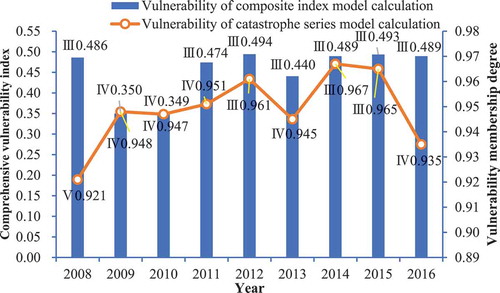
Through the vulnerability research of marine economic system, it provides decision support for the sustainable development of marine economy. Due to the differences of research perspective and object, the concept and mechanism of vulnerability of marine economic system have not been unified, which needs to be further defined and discussed. The definition and measurement methods of the vulnerability of marine economic system have not been unified, and the research methods are in urgent need of innovation and attempt. In the future research, we need to continue to improve the vulnerability research framework, systematically sort out the main research contents such as the selection of evaluation indicators, the reduction of evaluation indicator system, the determination of evaluation criteria, the calculation of index weight, the selection of evaluation model, the comparison of evaluation results, the analysis of main driving factors, the spatiotemporal differentiation of vulnerability, and the prediction of future vulnerability. It’s expected that the relevant theoretical system of vulnerability of marine economic system will be improved gradually.
Conclusions
First, the vulnerability of the marine economic system in 2009 and 2010 is in the fourth grade of poor state, and in the rest years are in the third level of general state based on the comprehensive index model. Especially since 2011, the vulnerability of marine economic system in Jiangsu Province has remained relatively stable, with a small fluctuation range. Based on the catastrophe progression model, it’s found that the vulnerability membership of Jiangsu marine economic system in 2014, 2015, and 2012 is at the third grade. In 2011, 2009, 2010, 2013, and 2016, it was in the poor state of grade IV. In 2008, it was in a very poor state of grade Ⅴ.
Second, based on the comparison of the index membership of the system layer in each evaluation year and the principal component analysis of the index system layer, it’s found that scale of marine industry (B1) and profit and loss of marine resources (B2) are the two main factors affecting the vulnerability of the marine economic system. Through the Pearson correlation analysis of the membership degree of the target layer and the system layer, it’s found that scale of marine industry (B1), profit and loss of Marine ecological (B3) have the highest correlation with the vulnerability of the marine economic system. Therefore, we can directly adopt or adjust policies to improve the recovery efficiency of the vulnerability of the marine economic system within the corresponding system layer indicators.
Third, the overall trend of the evaluation results of the two models is similar, and it’s found that 2014, 2015, and 2012 are in the third grade, which belongs to the general state. 2009 and 2010 are in the fourth grade, which is in a poor state. From 2008 to 2011, the vulnerability status is lower than that in 2012, and the overall volatility is small and stable. It’s found that the evaluation result of catastrophe progression model is more objective and cautious than that of comprehensive index model, which is closest to the actual situation of the economic added value of marine industry in each year.
Fourth, it’s found that to reduce the vulnerability of marine economic system in Jiangsu Province, it’s necessary to change the development mode, optimize the economic structure, and change the growth momentum. On the one hand, it’s necessary to optimize the marine industrial structure and promote the high-quality development of marine economy while improving the gross value of marine production. On the other hand, it’s necessary to promote the rational development of marine resources and enhance the utilization efficiency. In the process of marine economic development in the future, we need to pay more attention to structural characteristics, resource conservation, and environmental optimization, and deal with the coordination and development relationship between marine economy, resources, and environment.
Acknowledgments
The authors are very grateful to the anonymous reviewers for reading our manuscript and for providing suggestions.
Author contributions
Huihui Sun and Sheng Gao is the co-first author of this article. Sheng Gao proposed the research framework and drafted the paper. Huihui Sun worked on the analysis, interpretation of results, and the discussion. Further revision was carried out by Miaosen Ma, Yanyan Lu, and Yuan Yao. Professor Wei Liu directed the research work, proofread and polished the full text. All authors have read and approved the final manuscript.
Disclosure statement
No potential conflict of interest was reported by the authors.
Additional information
Funding
References
- Adrianto, L., and Y. Matsuda. 2002. “Developing Economic Vulnerability Indices of Environmental Disasters in Small Island Regions.” Environmental Impact Assessment Review 22 (4): 393–12. doi:10.1016/S0195-9255(02)00012-4.
- Adrianto, L., and M. Yoshiaki. 2004. “Study on Assessing Economic Vulnerability of Small Island Regions.” Environment, Development and Sustainability 6 (3): 317–336. doi:10.1023/B:ENVI.0000029902.39214.d0.
- Berrouet, M. L., J. Machado, and C. Villegas-Palacio. 2018. “Vulnerability of Socio—ecological Systems: A Conceptual Framework.” Ecological Indicators 84: 632–647. doi:10.1016/j.ecolind.2017.07.051.
- Chen, Y., S. S. Zhang, Y. Zhang, L. Xu, Z. J. Qu, G. B. Song, and J. Zhang. 2016. “Comprehensive Assessment and Hierarchical Management of the Sustainable Utilization of Urban Water Resources Based on Catastrophe Theory.” Journal of the Taiwan Institute of Chemical Engineers 60: 430–437. doi:10.1016/j.jtice.2015.10.048.
- Fernández-Macho, J., P. González, and J. Virto. 2020. “Assessing Anthropogenic Vulnerability of Coastal Regions: DEA-based Index and Rankings for the European Atlantic Area.” Marine Policy 119: 104030. doi:10.1016/j.marpol.2020.104030.
- Gao, S., H. H. Sun, G. X. Cao, L. Zhao, R. J. Wang, and M. Xu. 2019. “Dynamic Assessment of Island Ecological Environment Sustainability under Urbanization Based on Rough Set, Synthetic Index and Catastrophe Progression Analysis Theories.” Ocean and Coastal Management 178: 104790. doi:10.1016/j.ocecoaman.2019.04.017.
- Guillaumont, P. 2010. “Assessing the Economic Vulnerability of Small Island Developing States and the Least Developed Countries.” Journal of Development Studies 46 (5): 828–854. doi:10.1080/00220381003623814.
- Hu, W., Y. Hu, Z. D. Hu, Y. Huang, and M. Ren. 2019. “Emergy-based Sustainability Evaluation of China’s Marine Eco-economic System during 2006–2015.” Ocean & Coastal Management 179: 104811. doi:10.1016/j.ocecoaman.2019.05.013.
- Kantamaneni, K., M. Phillips, T. Thomas, and R. Jenkins. 2018. “Assessing Coastal Vulnerability: Development of a Combined Physical and Economic Index.” Ocean & Coastal Management 158: 164–175. doi:10.1016/j.ocecoaman.2018.03.039.
- Lakhvinder, K., S. R. Madhuri, S. Gagandeep, and S. N. Thakur. 2020. “Groundwater Potential Assessment of an Alluvial Aquifer in Yamuna Sub-basin (Panipat Region) Using Remote Sensing and GIS Techniques in Conjunction with Analytical Hierarchy Process (AHP) and Catastrophe Theory (CT).” Ecological Indicators 110: 105850. doi:10.1016/j.ecolind.2019.105850.
- Lauerburg, R. A. M., R. Diekmann, B. Blanz, K. Gee, H. Held, A. Kannenc, C. Möllmanne, et al. 2020. “Socio-ecological Vulnerability to Tipping Points: A Review of Empirical Approaches and Their Use for Marine Management.” Science of the Total Environment 705: 135838. doi:10.1016/j.scitotenv.2019.135838.
- Li, B., F. Su, Z. Yang, Z. L. Han, and F. Peng. 2018. “Vulnerability-based Analysis of the Spatial-temporal Dynamic Patterns of the Human-sea Territorial System of the Bohai-rim Region, China.” Acta Ecologica Sinica 38 (4): 1436–1445.
- Lv, S. L., R. X. Yang, and C. C. Huang. 2017. “Contusion and Recovery of Individual Cognition Based on Catastrophe Theory: A Computational Model.” Neurocomputing 220 (12): 210–220. doi:10.1016/j.neucom.2016.05.099.
- Ma, X., M. D. Jong, B. Q. Sun, and X. Bao. 2020. “Nouveauté or Cliché? Assessment on Island Ecological Vulnerability to Tourism: Application to Zhoushan, China.” Ecological Indicators 113: 106247. doi:10.1016/j.ecolind.2020.106247.
- Nadiri, A. A., Z. Sedghi, R. Khatibi, and S. Sadeghfam. 2018. “Mapping Specific Vulnerability of Multiple Confined and Unconfined Aquifers by Using Artificial Intelligence to Learn from Multiple DRASTIC Frameworks.” Journal of Environmental Management 227: 415–428. doi:10.1016/j.jenvman.2018.08.019.
- Nelson, R. B., J. N. William, B. Jarbas, A. Giorgio, and N. J. Victor. 2020. “Vulnerability Assessments as a Tool for the Coastal and Marine Hazards Management: An Overview.” Ocean & Coastal Management 189: 105134. doi:10.1016/j.ocecoaman.2020.105134.
- Reimer, M. N., and A. C. Haynie. 2018. “Mechanisms Matter for Evaluating the Economic Impacts of Marine Reserves.” Journal of Environmental Economics and Management 88: 427–446. doi:10.1016/j.jeem.2018.01.009.
- Roopnarine, P. D. 2008. “Catastrophe Theory. Reference Module in Earth Systems and Environmental Sciences.” Encyclopedia of Ecology 10: 531–536. doi:1016/B978–008045405–4.00146–4.
- Sadeghfam, S., Y. Hassanzadeh, A. A. Nadiri, and M. Zarghami. 2016. “Localization of Groundwater Vulnerability Assessment Using Catastrophe Theory.” Water Resources Management 30: 4585–4601. doi:10.1007/s11269-016-1440-5.
- Sadeghfam, S., R. Khatibi, S. Dadashi, and A. A. Nadiri. 2020a. “Transforming Subsidence Vulnerability Indexing Based on ALPRIFT into Risk Indexing Using a New Fuzzy-catastrophe Scheme.” Environmental Impact Assessment Review 82: 106352. doi:10.1016/j.eiar.2019.106352.
- Sadeghfam, S., R. Khatibi, R. Daneshfaraz, and H. B. Rashidi. 2020b. “Transforming Vulnerability Indexing for Saltwater Intrusion into Risk Indexing through a Fuzzy Catastrophe Scheme.” Water Resources Management 34: 175–194. doi:10.1007/s11269-019-02433-2.
- Senapati, S., and V. Gupta. 2017. “Socio-economic Vulnerability Due to Climate Change: Deriving Indicators for Fishing Communities in Mumbai.” Marine Policy 76: 90–97. doi:10.1016/j.marpol.2016.11.023.
- Sun, C. Z., Q. Cao, and Z. Y. Wang. 2019. “Vulnerability Evaluation of Marine Economic System in the Coastal Area of Bohai Rim.” Economic Geography 39 (5): 37–46. doi:10.15957/j.cnki.jjdl.2019.05.005.
- Sun, C. Z., X. H. Qin, B. Li, and Z. Y. Wang. 2016. “Assessment of Marine Economy Vulnerability of Coastal Cities in Bohai Sea Ring Area Based on WSBM Model.” Scientia Geographica Sinica 36 (5): 705–714. doi:10.13249/j.cnki.sgs.2016.05.008.
- Wang, W. J., S. L. Liu, S. S. Zhang, and J. W. Chen. 2011. “Assessment of a Model of Pollution Disaster in Near-shore Coastal Waters Based on Catastrophe Theory.” Ecological Modelling 222 (2): 307–312. doi:10.1016/j.ecolmodel.2010.09.007.

